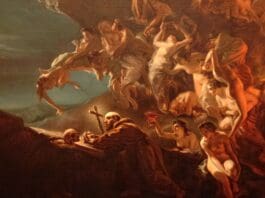
Saint Hilarion, originally hailing from the village of Tabatha, south of Gaza, was born to parents who practiced idolatry. His educational journey took him to Alexandria, where he encountered the Christian faith and chose to be baptized at the age of fifteen. Intrigued by the stories of St. Anthony, he ventured into the desert to live with him for two months, learning from his ascetic lifestyle.
However, Hilarion found the desert to be distracting, as many sought St. Anthony’s help for healing and exorcism. Craving solitude to serve God, he returned to his homeland, only to find that his parents had passed away. He distributed his inheritance, giving portions to his siblings and the rest to the poor, keeping nothing for himself. He then withdrew to the desert, seven miles from Majuma, sandwiched between the seashore and a swamp. His attire was simple: a sackcloth shirt, a leather tunic gifted by St. Anthony, and a modest cloak. He only replaced his tunic when it was completely worn out and never washed his sackcloth.
Hilarion sustained himself on fifteen figs daily, which he ate only at sunset. His days were filled with farming and basket weaving, ensuring he had the essentials for survival. He built a cell for himself, so small it resembled a tomb more than a home. Over time, he realized that figs alone could not sustain him, and he expanded his diet to include vegetables, bread, and oil.
During his isolation, he faced intense temptations through demonic visions and hallucinations. He persevered, relying on his faith to guide him through these challenging times.
In 356, he learned of St. Anthony’s death through a divine revelation. By this time, he was sixty-five and growing weary of the constant attention from pilgrims and the responsibility of guiding his disciples. He decided to leave Palestine, despite the crowds that gathered, hoping to persuade him to stay. He fasted for seven days, convincing the people to let him leave.
Hilarion then chose a group of monks capable of fasting until sunset and journeyed to Egypt, eventually reaching St. Anthony’s mountain near the Red Sea. There, he found two of St. Anthony’s disciples and explored the secluded cells where St. Anthony would retreat from visitors. Despite his curiosity, the location of St. Anthony’s grave remained a secret, as per his wishes.
Seeking further solitude, St. Hilarion traveled to Aphroditopolis (Atfiah), then to a nearby desert, and finally to a western desert oasis. However, his reputation followed him everywhere. Deciding to find a place where he was completely unknown, he and a companion sailed to Sicily.
In Sicily, he and his companion found an isolated spot, but his identity was soon discovered. Fleeing again, he traveled inland, finally finding a secluded yet pleasant place to live. Despite his best efforts to live in obscurity, his miracles made him known. As he pondered his next steps, he realized that even in silence, his deeds spoke volumes.
Eventually, he found refuge in Cyprus, settling two miles from Paphos. Yet once again, his identity was revealed, forcing him to move further inland to a remote yet serene location. Here, he found the peace and quiet he longed for and lived out his final years, passing away at the age of eighty. St. Epiphanius, Bishop of Salamis, visited him during his last illness and later shared the story of his life with St. Jerome. Following his death, St. Hesychius, a disciple of St. Hilarion, secretly transported his body back to Majuma, his original home.
Photo credit: Public Domain via Wikimedia Commons
The post Saint Hilarion appeared first on uCatholic.
Daily Reading
Memorial of Saints Basil the Great and Gregory Nazianzen, Bishops and Doctors of the Church
Readings for the Memorial of Saints Basil the Great and Gregory Nazianzen, Bishops and Doctors of the Church Reading 1 1 John 2:22-28 Beloved: Who is the liar? Whoever denies…
Daily Meditation
A Voice in Today’s WildernessUna voz en la jungla de hoy día
Click here for daily readings Today’s Gospel passage is especially relevant as we begin a new year with resolutions and hope. In this reading we hear John’s declaration echoing the…




